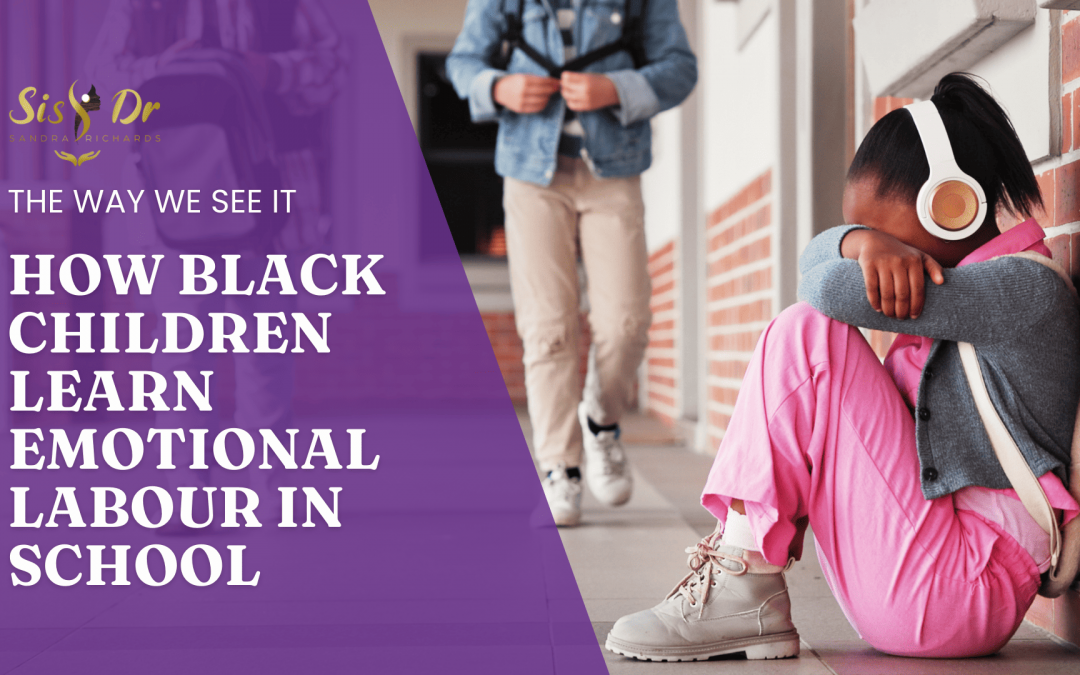Picture this: a child walks into school each morning, not only carrying books and homework but also carrying the unspoken demand to shrink parts of themselves. Before the lesson even begins, their energy is already spent—not on learning, but on calculating how much of their voice, expression, or culture is safe to show that day.
This is the unseen cost of schooling for many Black children in Britain. It is not simply about inclusion in the curriculum or representation in leadership. It is about the daily performance of identity management. The effort to appear non-threatening, to sound ‘acceptable’, to keep hair, clothing, and gestures within invisible lines set by Eurocentric ideals.
Emotional Labour at School
The term emotional labour is usually spoken about in workplaces, but The Way We See It makes clear that Black children carry this burden long before they enter employment.
From a young age, many are required to self-monitor in ways their peers are not. They learn to suppress joy that might be called ‘rowdy’, curiosity that might be seen as ‘challenging’, or cultural expression that might be labelled ‘inappropriate’.
One of the findings in my publication, “The Way We See It,” describes how pupils were praised when they conformed to a quiet, compliant standard, yet penalised when they brought cultural energy or assertiveness into the classroom.
Children themselves noted that they felt ‘watched more closely’ than their peers, and that they often stayed silent rather than risk being misinterpreted. This demonstrates that what schools call ‘good behaviour’ can in reality mean erasing yourself.
The Hidden Curriculum of Compliance
When a child spends an entire school day censoring their words, gestures, and even facial expressions, their energy is pulled away from the things that fuel learning—curiosity, focus, and collaboration. Instead, it is consumed by the constant task of monitoring how they are seen, calculating risks, and trying to stay invisible enough to avoid reprimand.
This vigilance does more than tire them; it slowly erodes confidence and wellbeing. Over time, many children become withdrawn, anxious, or resigned to the idea that classrooms are designed for others, not for them.
What looks like effective behaviour management is often something else: identity suppression masked as discipline. A child may remain physically present in the classroom, yet their sense of belonging and safety has already been stripped away.
Patterns that Last a Lifetime
What begins in childhood rarely ends at the school gates. Emotional labour becomes a way of life—showing up in workplaces, relationships, and even in mental health struggles carried into adulthood. The child who once learned to ‘tone down’ to survive the classroom often grows into the adult who tones down at work, at home, or in community spaces.
Internalised exclusion does not end when childhood does. It morphs into patterns of self‑erasure that shadow a person into adulthood. To treat this only as a matter of classroom discipline misses the truth: it is fundamentally about wellbeing.
What Needs to Change
If schools are serious about inclusion, they must recognise and reduce this invisible weight. That means:
-
Questioning discipline frameworks that reward silence and conformity over authentic expression.
-
Embedding cultural safety so that belonging is not conditional on assimilation.
-
Listening to children’s voices not as a token gesture but as vital evidence of what wellbeing in education truly requires.
Wellbeing cannot exist in a classroom where identity is policed, muted, or erased. True belonging is not achieved when children learn to carry the weight silently, but when the system commits to removing the weight altogether.
About The Way We See It
This article draws from SisDr’s publication The Way We See It (2008), a critical exploration of exclusion in British education. It amplifies the lived realities of Black children and families, exposing how systemic practices undermine identity and wellbeing. It challenges educators and policymakers to reimagine schools as places where cultural belonging is not an exception but the standard.

